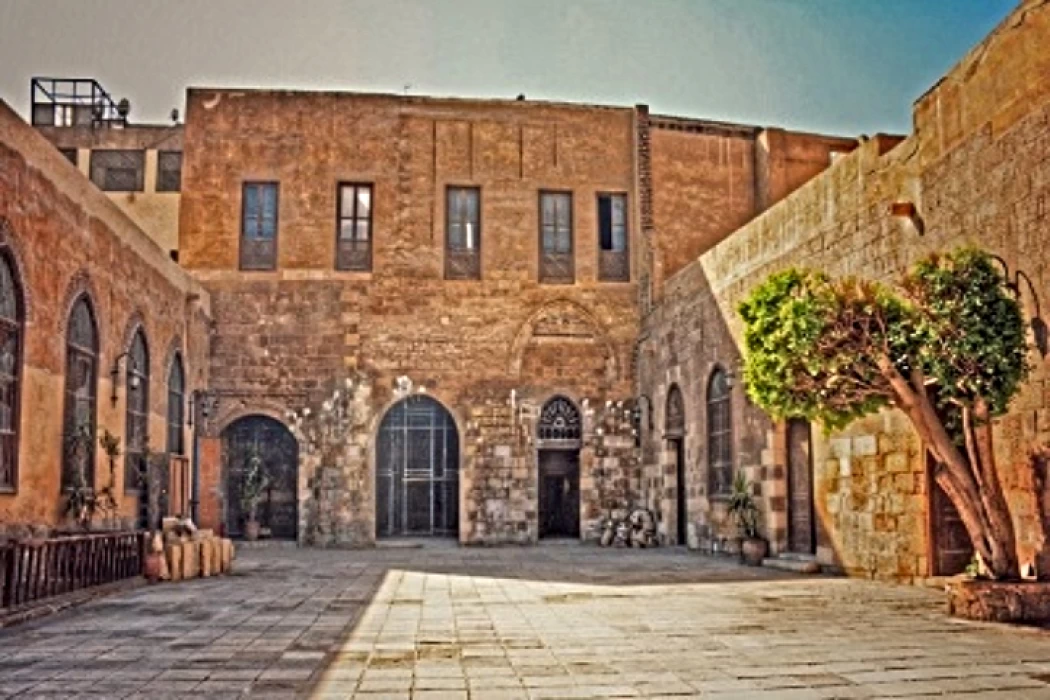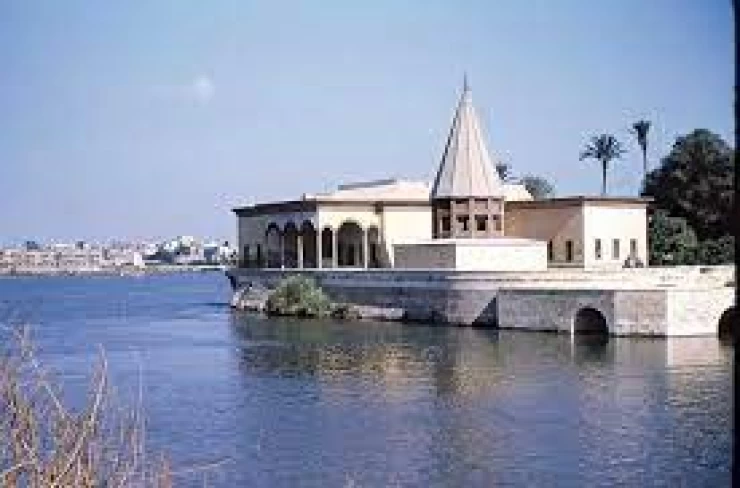
Discover Prince Taz Palace
The palace is located in Old Cairo, in the Khalifa area of the castle, on Al-Suyufiya Street, branching from Saliba Street.
A few dozen years had passed, and the Ministry of Education vacated the palace not for restoration and preservation after it showed signs of aging clearly, Because the palace is large and spacious and located in the heart of Cairo, it was qualified from the ministry's point of view to be the main storage for hundreds of thousands of textbooks, dozens of vehicles that were speculated, and hundreds of tons of scrap of various kinds.. And because people are religious to their kings, the inhabitants of the region did not feel embarrassed to use the palace as a cemetery for dead animals!.. The palace did not endure all this humiliation, and it witnessed and witnessed hundreds of years of solitude and bliss, so it folded itself after being raided by diseases and ailments, many of its walls swayed, and many of its rooms collapsed.
In October 1992, the palace was admitted to the intensive care room after the winds of the famous earthquake hit many of its pillars and pillars, and for ten years the situation remained the same until death was declared clinically on March 10, 2002, when a large part of the rear wall of the palace overlooking a narrow lane with dozens of dilapidated houses inhabited by hundreds of thousands of citizens collapsed, all their lives became threatened by the expected danger from moment to moment after the complete collapse of the Palace became a matter of hours no more.. The Ministry of Culture started the restoration project of the Palace after being neglected for long periods, but the task was very difficult due to the damage to many parts.. International expert houses and foreign experts considered that the topic was already over and that any attempts to save were a waste of time.. And because the Egyptians' most prominent hobby at a time of distress is to challenge the impossible, or what seems to others impossible.. Everyone rushed to the site of the collapsed Palace, and in moments, the ventilators and heart massage began to work at a miraculous speed, and the rescue operation was completed. The world stood dazzled as he saw life returning to the palace, which was restored with indescribable efficiency.
The Egyptians were not satisfied with the rescue and restoration, but the biggest surprise was the important archaeological discoveries that accompanied it and led to the unveiling of more of the palace's secrets.. The work that has been done is wonderful by all standards, so Star News decided to take you on a quick tour to get to know the story from the very beginning.The total area of the palace is more than eight thousand square meters, and it has a large courtyard in the center.
The main interface
The main entrance to the palace is a coherent block that begins with a rectangular corridor with a door behind it, one at the end of which is a cellar on both sides of two entrances, each of which opens onto a rectangular courtyard, which is the palace's courtyard, and this complete entrance overlooks Al-suyufiya Street.
main Lower Hall, the walls of which are covered with a layer of plaster that fits the stones with which the hall was originally built. As for the private part of the Haram, it overlooks the courtyard or garden with a set of windows made of 'baghdadli' wood, which is a unique masterpiece and is topped by three round windows, which are known as the qomriyat and the palace, two Iwan, one on the north side, the other on the south side, and the northern Iwan is a square covered with a roof with geometric and Botanical Al-makhdoumi Al-Ghazi Al-mujahidi Al-mourabiti', which are all titles specific to Prince Taz, as these writings are mediated by a drawing of a cup symbolizing the job of a bartender One of the jobs held by Prince Taz. There is also the main seat or reception hall, it consists of two levels connected by a staircase, and in each of its levels it is a rectangular space overlooking the courtyard, similar to a 'terrace' based on three columns of khart wood, and under the ceiling a wooden Izar is containing copied writings of the initial verses of Surah Al-Fath, and attached to this seat are three halls full of geometric decorations.
Restoration of the palace
When the collapse began in the back wall of the palace overlooking Sheikh Khalil Lane, the emergency team rushed there, where they found that the wall is twenty-five meters high. It is the height of a nine-story building! Part of it collapsed and the rest of the wall was tilted towards the Houses of Al-Hara and the mile reached half a meter, so the initial plan to stop the deterioration was twofold in a row, the first was to make supports to stop any new collapse and remove the backfill piles on the roof, which represent a heavy load that may help any Coming Collapse, as well, this crack included building shirts or brick walls around the wall to fix it and prevent it from falling, and this stage was very dangerous for workers, as a twenty-five-meter-high wall and a very tall facade threatened to collapse over their heads at any moment, but these workers they faced this danger and agreed to it under their responsibility.The second step was to divide the palace into parts and then disassemble each part separately with great care, just as the Antiquities Authority had previously dismantled many pharaonic temples, the most famous and largest of which was the temple of Abu Simbel, noting that the temples on their majesty were in the end coherent stone blocks that were not threatened with collapse, unlike the palace, which was swaying and dancing, as well as it is composed of either blocks or very small stone pieces compared to the temples or timber! This stage was accompanied by an intensive monitoring process for fear of a sudden collapse that threatens the lives of the residents of the area and the project workers. When the operation was successful and the team discovered that the slope had been reduced by the supports and the movement of buildings in general had stopped, the plan for dismantling the entire palace was modified and modified to limit this dismantling to the dilapidated parts only. the largest and most important thing that was dismantled was a full loft that was a major part of the campus.
Also, one of the most important areas of the palace that was completed was the bathroom area on the ground and upper floors, with gypsum ceilings topped with small domes that were full of decorative elements.
Restoration and discoveries
After the first and most dangerous stages, namely the isolation of sensitive parts threatened with falling either by complete dismantling or by building new walls around them to serve as protective shirts protecting them, the restoration and reconstruction of the entire palace began. openings and entrances to basements and domes, followed by sorting the original components of the palace that were mixed with these residues when the October 92 earthquake occurred or when the last collapse in March 2002, and this process resulted in the finding of a huge amount of wooden elements The metal and stone that had the greatest impact on the return of the palace to its old splendor with the same original components as possible.
Restored writings
Among the most important archaeological elements of the palace that have undergone processing and restoration processes are decorative or deaf wood, marble, and metal elements, the limestone layer that coats .
A marble column with a Corinthian Crown
If all these stages and all this precision were for a part of the wooden composition in some parts of the Palace, then we can imagine the amount of work that was done on dozens of other details, from floors, walls, columns, stairs, metal parts, and other components.. Haven't we assured you from the very beginning that it's an integrated epic and not just a rescue operation. It is confirmed that it is an epic this important and exciting number of discoveries that accompanied the rescue and restoration operations, the most important and most exciting of which was a huge aquarium for ornamental fish that was used to add an aesthetic touch, although there is an opinion that this aquarium may have been used as a swimming pool for the neighbors of the palace.
A fountain with a ground seat and a fountain on top of a water well were also revealed, which was intended for watering the horses and irrigating the garden, as well as a marble column with a Corinthian crown dating back to the Byzantine era, a water tank that was a source of nutrition for Ali Agha Avenue attached to the palace, a set of pottery sewers, which are almost identical to drainage pipes in modern times, and basins for the horses, some near the entrance leading to the ground seat, some on the edge of the palace overlooking Al-suyufiya Street and several other important discoveries. Currently, many concerts are held in the palace to celebrate Arabic music, and many workshops are held for children, such as painting, singing, sculpture, some seminars, and political meetings after the January 25 Revolution.
The second sector, to which the hand of repair and restoration extended, is the Avenue and the book of Ali Agha Dar Al-Saada, and this entire monument is part of the Prince Taz Palace.
All these defects were remedied during the restoration operations, which restored the whiteness with the original moon materials, replaced the non-archaeological floors according to the archaeological origin, and the cracks of the staircase were injected and secured.















